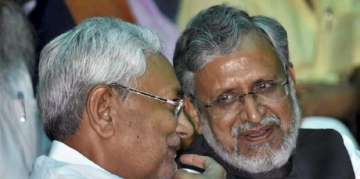Nitish Kumar has been chosen as the chief minister of Bihar yet again, dispelling the scope for any infighting that was speculated as the Bharatiya Janata Party (BJP) earned the "big brother" tag for the first time this poll season. Kumar will continue to be at the helm of political affairs in Bihar with Sushil Kumar Modi as his deputy. The duo has been selected at a key meeting of the National Democratic Alliance (NDA) which has JD(U), BJP, HAM and Vikassheel Insaan Party as its constituents. Kumar was elected as the NDA legislature party leader at the meeting while Modi was roped in as his second-in-command despite reports stating that a Dalit leader could be zeroed in on. Nitish Kumar will take oath as the chief minister for a fourth successive term on Monday with Sushil Modi alongside. The swearing-in ceremony will be held post 4 pm tomorrow. It is said that the day has been chosen as it marks 'Bhaiyya Dooj' festival which is considered auspicious. ALSO READ | Nitish Kumar to take oath as CM tomorrow, Sushil Modi as his deputy
Nitish Kumar headed to the Raj Bhawan Saturday afternoon where he staked claim to form his government in Bihar. Earlier on Friday, he met Governor Phagu Chauhan and tendered his resignation with a recommendation to dissolve the state assembly.
Nitish Kumar is known for weighing his options carefully before making any move. He comes across as a risk-taker who has not shied away from going against the tide. During his rule, Nitish stood out for his ability to address the governance deficit. Upon being administered the oath of office, Kumar will hold the distinction of having been sworn in seven times as chief minister in two decades. He first took oath as chief minister in 2000 when the state threw up a hung assembly but resigned a few days later for want of adequate number of MLAs backing him. In 2005, Kumar became the chief minister after the NDA secured a full majority, and returned to power five years later. In 2014, he stepped down owning moral responsibility for the JD(U)'s debacle in the Lok Sabha polls but returned as the CM less than a year later.
ALSO READ | Nitish Kumar swearing-in ceremony: Date, time, and other details
In November 2015, the Grand Alliance comprising the JD(U), RJD and the Congress, which declared him as its chief ministerial candidate, won the assembly elections and Kumar was again sworn in. In July, 2017 he stepped down heeding his "inner voice" which had been tormenting him over his then deputy Tejashwi Yadav's name cropping up in a money laundering case. Kumar was, however, sworn in again the very next day when he formed a new government with the BJP.
The saffron party secured 74 seats in the assembly election the JD(U) managed 43 seats. Other alliance partners HAM and Vikassheel Insaan Party got 4-each, powering NDA's tally to 125 as opposed to 110 clinched by the opposition Grand Alliance.
ALSO READ | Nitish Kumar and his journey: Up and down the ladder
Latest India News
